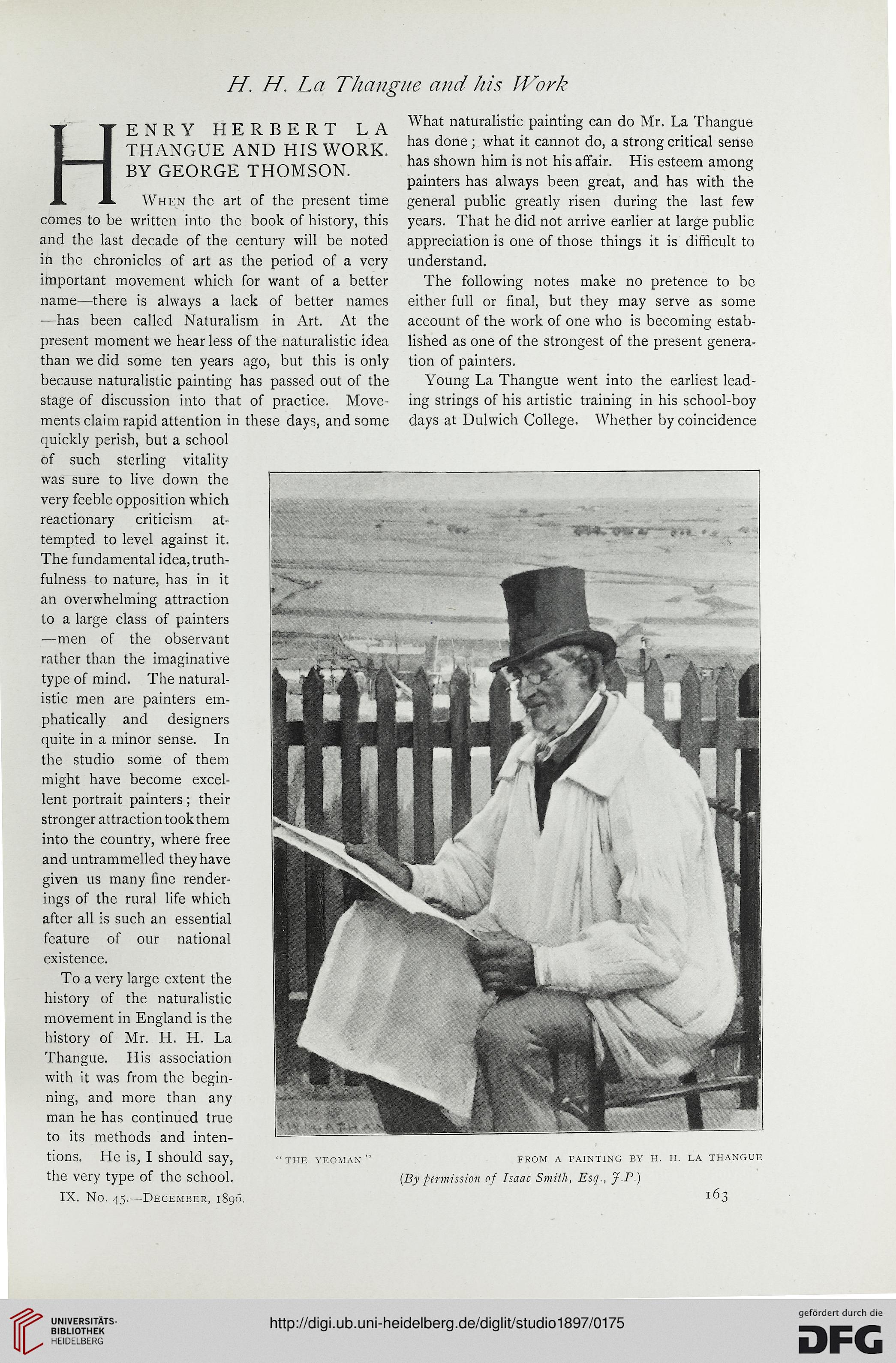H. H. La Thangue and his IVork
ENRY HERBERT LA ^nat naturalistic painting can do Mr. La Thangue
ttto nrATDT/ has done : what it cannot do, a strong critical sense
THANGUE AND HIS WORK. , . ,. . ,. ~. TT.
has shown him is not his affair. His esteem among
BY GEORGE THOMSON. . , , , , , ., ,
painters has always been great, and has with the
When the art of the present time general public greatly risen during the last few
comes to be written into the book of history, this years. That he did not arrive earlier at large public
and the last decade of the century will be noted appreciation is one of those things it is difficult to
in the chronicles of art as the period of a very understand.
important movement which for want of a better The following notes make no pretence to be
name—there is always a lack of better names either full or final, but they may serve as some
—has been called Naturalism in Art. At the account of the work of one who is becoming estab-
present moment we hear less of the naturalistic idea lished as one of the strongest of the present genera-
than we did some ten years ago, but this is only tion of painters.
because naturalistic painting has passed out of the Young La Thangue went into the earliest lead-
stage of discussion into that of practice. Move- ing strings of his artistic training in his school-boy
ments claim rapid attention in these days, and some days at Dulwich College. Whether by coincidence
quickly perish, but a school
of such sterling vitality
was sure to live down the
very feeble opposition which
reactionary criticism at-
tempted to level against it.
The fundamental idea, truth-
fulness to nature, has in it
an overwhelming attraction
to a large class of painters
—men of the observant
rather than the imaginative
type of mind. The natural-
istic men are painters em-
phatically and designers
quite in a minor sense. In
the studio some of them
might have become excel-
lent portrait painters; their
stronger attraction took them
into the country, where free
and untrammelled they have
given us many fine render-
ings of the rural life which
after all is such an essential
feature of our national
existence.
To a very large extent the
history of the naturalistic
movement in England is the
history of Mr. H. H. La
Thangue. His association
with it was from the begin-
ning, and more than any
man he has continued true
to its methods and inten-
tions. He is, I should say, "the yeoman" from a painting by h. h. la thangue
the very type of the school. (By permission of Isaac Smith, Esq., J.P.)
IX. No. 45.—December, 1896.
ENRY HERBERT LA ^nat naturalistic painting can do Mr. La Thangue
ttto nrATDT/ has done : what it cannot do, a strong critical sense
THANGUE AND HIS WORK. , . ,. . ,. ~. TT.
has shown him is not his affair. His esteem among
BY GEORGE THOMSON. . , , , , , ., ,
painters has always been great, and has with the
When the art of the present time general public greatly risen during the last few
comes to be written into the book of history, this years. That he did not arrive earlier at large public
and the last decade of the century will be noted appreciation is one of those things it is difficult to
in the chronicles of art as the period of a very understand.
important movement which for want of a better The following notes make no pretence to be
name—there is always a lack of better names either full or final, but they may serve as some
—has been called Naturalism in Art. At the account of the work of one who is becoming estab-
present moment we hear less of the naturalistic idea lished as one of the strongest of the present genera-
than we did some ten years ago, but this is only tion of painters.
because naturalistic painting has passed out of the Young La Thangue went into the earliest lead-
stage of discussion into that of practice. Move- ing strings of his artistic training in his school-boy
ments claim rapid attention in these days, and some days at Dulwich College. Whether by coincidence
quickly perish, but a school
of such sterling vitality
was sure to live down the
very feeble opposition which
reactionary criticism at-
tempted to level against it.
The fundamental idea, truth-
fulness to nature, has in it
an overwhelming attraction
to a large class of painters
—men of the observant
rather than the imaginative
type of mind. The natural-
istic men are painters em-
phatically and designers
quite in a minor sense. In
the studio some of them
might have become excel-
lent portrait painters; their
stronger attraction took them
into the country, where free
and untrammelled they have
given us many fine render-
ings of the rural life which
after all is such an essential
feature of our national
existence.
To a very large extent the
history of the naturalistic
movement in England is the
history of Mr. H. H. La
Thangue. His association
with it was from the begin-
ning, and more than any
man he has continued true
to its methods and inten-
tions. He is, I should say, "the yeoman" from a painting by h. h. la thangue
the very type of the school. (By permission of Isaac Smith, Esq., J.P.)
IX. No. 45.—December, 1896.




